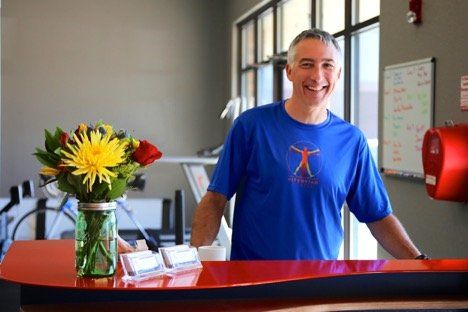What To Expect from a Vitruvian Fitness Private Fitness Consultation
Congratulations! You’ve signed up for personal training. Let’s get started.
When you made the decision to hire a personal trainer, it’s safe to say it’s because you need or want to make some changes in your life that you need help with. Depending on your goals, some of the changes and choices you’ll make may feel overwhelming. Thankfully, the expert trainers at Vitruvian Fitness will make achieving those goals easier. And it all starts at your very first session. Here’s what to expect from your private fitness consultation:
Expect to get personal
They call it “personal” training for a reason. When you schedule a private fitness consultation, you’re taking the first step to a wholly customized experience every time you enter the gym. In order to do that, your trainer needs to get to know you – in pretty significant detail. What is your exercise history? What types of training have you done before? What type of results did you get? What did you like? What didn’t you like? Who did you work with before? What did you like or dislike about them?
Do you have a background in athletics – recreational or competitive? Are you currently participating in any athletic, sporting, or otherwise recreational activity? How satisfied are you with your performance?
The more detailed you can be about your experiences with fitness, the better. Don’t be afraid to be honest! We’re here to make sure that you’re motivated and engaged every time you come to the gym, especially when that means avoiding styles that you know don’t work for you.
Along with your fitness history, your personal trainer needs to understand your medical background. Disclosing any injuries, surgeries, and specific health concerns helps him or her develop a plan that will work with you instead of against you. For women, this may also include talking about medical issues related to childbirth and your pelvic floor.
Expect to talk about your goals
Earl Nightingale said, “All you need is the plan, the road map, and the courage to press on to your destination.” Steven Covey said, “Begin with the end in mind.” Tom Wigginton asks, “What are you here for?”
No matter what you’re reaching for, it’s important to set goals with your personal trainer as a means to measure your growth. Your fitness goals don’t need to be exclusively about the numbers, either. It’s just as valid and worthy to aim for feeling better, moving better, or having less pain as it is to aim for improving your performance in a triathlon. Your goal may even be something incredibly specific, and that’s fine, too. What’s important is that you know what you want to work toward.
And it’s totally okay if you don’t know how to quantify your goals in the beginning. As you begin to experience what progress looks like, you can begin to set some measurable goals to help design your road map. While you may change them over time, having a base from which to start is key to measuring your success.
At Vitruvian Fitness, you’ll do a movement assessment called the Functional Movement Screen.
Your personal trainer needs to understand how well you’re capable of moving to know where to begin. When you schedule a private fitness consultation, our expert personal trainers will assess where you are and where you can improve. The Functional Movement Screen™ is an excellent tool that a personal trainer should use to help customize your fitness plan. The screen will show where you excel and where you have room to improve, and what, if anything, needs to be fixed before you start to add volume and intensity to your program. You wouldn’t jump on the highway in your car if your brakes didn’t work well, would you? Don’t do the same with your body. In the end, this will help you make steady, uninterrupted progress toward achieving your goals in a healthier, more productive way.
Expect to build a partnership
When you have a private fitness consultation, you should, first and foremost, be looking to create a working relationship with an expert. The trainer with whom you work should be empathetic and compassionate, with an awareness of where you are in your life and how that can impact your fitness. A great personal trainer doesn’t shame or bully her or his clients; instead, she or he builds a lasting partnership based on empathy, mutual enthusiasm for achieving your goals, and an awareness of your needs. A great personal trainer will not use any shame-based sale techniques to sell a program to you. After all, a great personal trainer is there to help you take care of yourself; shame holds no place in the path to physical fitness.
At Vitruvian Fitness, our team of experts is dedicated to providing clients with unmatched personal training built on trust, kindness, and knowledge. Scheduling a private fitness consultation with one of the talented trainers on our team is a great way to take the next step in your fitness journey.
Contact us now to find a personal trainer who will tailor your fitness experience to your unique goals and needs.
You might also enjoy these posts . . .








